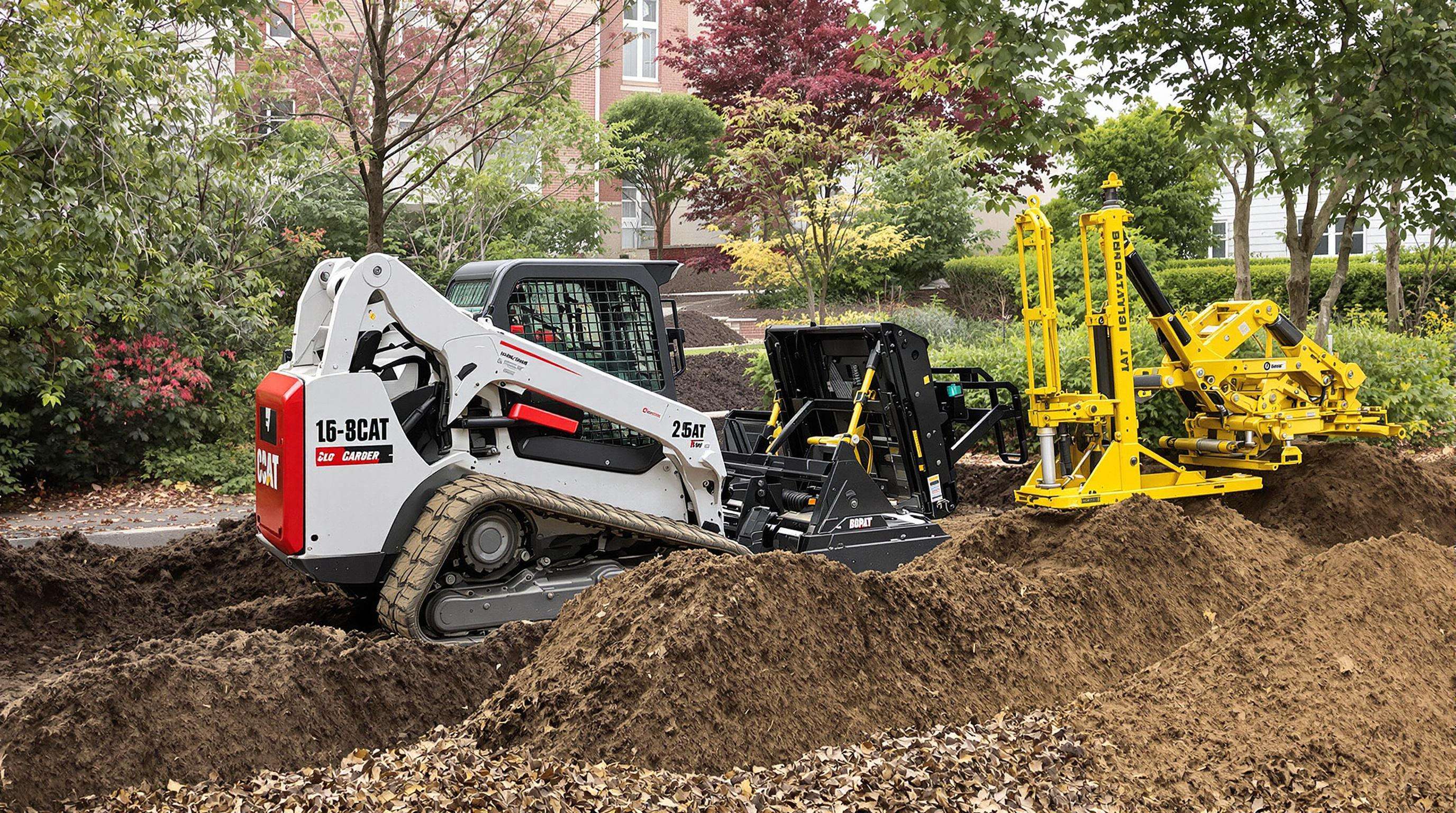Why Skid Steer Loaders Are Essential for Modern Landscaping
The Critical Role of Skid Steer Loaders in Modern Landscaping
Understanding the Role of Skid Steer Loaders in Landscaping
The skid steer loader has really changed how we approach landscaping work thanks to its small size but huge range of capabilities. These little beasts can do everything from leveling ground to digging holes and moving all sorts of materials around, basically doing the job of several different machines at once. What makes them so great is that they can turn on a dime and their weight is spread out just right, which means they can maneuver through crowded areas without tearing up the grass or pavement. That's why folks working on home gardens as well as big construction sites find them absolutely indispensable these days.
How Skid Steer Loaders Streamline Complex Landscaping Workflows
What makes skid steer loaders so popular? Their quick attach systems allow operators to switch attachments really fast - think going from a grading bucket to a trencher in less than two minutes flat. The time saved here is massive. Compared to old school methods where changing tools took forever, these modern machines cut down downtime by around three quarters. And this means construction sites don't need half a dozen different machines sitting around doing nothing. Contractors who have adopted skid steers report getting their work done approximately 30 percent quicker overall. For small businesses especially, this kind of efficiency can make all the difference when trying to stay competitive in tight markets.
Rising Adoption of Compact Construction Equipment in Urban Landscaping
The push toward urban living has led to around 40% more skid steers being used for landscaping work in cities since 2022. These compact machines typically measure less than eight feet wide, making them ideal for squeezing through tight spots like narrow gates and alleyways. Their tracked design also helps protect grassy areas when working in parks and public gardens. City officials increasingly favor skid steers for all sorts of tasks from basic lawn maintenance to setting up green infrastructure projects and doing detailed paving work in crowded neighborhoods where bigger machinery simply won't fit. The smaller size doesn't mean compromised capability either, as these machines handle most jobs that would traditionally require larger equipment.
Versatility in Action: Key Landscaping Tasks Enhanced by Skid Steer Loaders

Skid steer loaders enhance landscaping efficiency through specialized attachments that perform diverse tasks with precision and speed.
Grading and leveling for precision terrain shaping
Equipped with grading buckets and laser-guided systems, skid steers shape terrain with high accuracy. Their compact size allows fine adjustments for patios and drainage slopes, reducing rework and ensuring consistent results.
Excavation for foundations and footings using specialized attachments
Hydraulic augers and mini-excavator arms enable skid steers to dig foundation trenches and pier holes in confined areas. Full 360° visibility helps operators avoid underground utilities while maintaining consistent depth.
Material handling and transport with pallet forks and buckets
High-flow hydraulics support lifting 1,500-pound loads on slopes up to 45°. Dump-and-spread buckets distribute 14 cubic yards of mulch per hour, replacing three-person crews with a single operator.
Attachment Versatility: The Game-Changing Advantage of Skid Steer Loaders
How quick-attach systems maximize functionality and reduce downtime
Quick-attach systems let operators switch between buckets, augers, and trenchers in under a minute—without leaving the cab. This seamless transition saves over 30 minutes per day and reduces injury risks by eliminating manual handling. The result is higher equipment utilization (above 85%) and greater task completion per shift.
Essential attachments for landscaping: augers, tree spades, grading buckets, and more
With the right attachments, skid steers become incredibly versatile machines for all sorts of jobs around the property. Hydraulic augers can drill those pesky planting or fence post holes in no time at all. Tree spades make moving young trees much easier without damaging their roots. Grading buckets? They're amazing for getting soil just right down to almost exact measurements. When it comes to irrigation work, trenchers cut through the ground so much quicker than trying to dig by hand someone actually said about three times faster! And let's not forget about grapples that grab branches and clear away brush so effortlessly. Pallet forks save folks from having to move materials multiple times between spots, which saves both time and back pain. Those specialized landscaping buckets really help get dirt distributed evenly across flower beds and gardens too.
Case Study: Reducing equipment costs by 40% through strategic attachment use
When GroundsCare Solutions tackled a city park renovation project, they brought along their grading bucket, tree spade, and trencher instead of hauling in all sorts of extra machinery like compactors, excavators, and those big transplant machines. This approach saved them a bundle on equipment costs, cutting expenses by around 40%, which amounted to about $120k in savings. Plus, transportation fees dropped by roughly 35% since there was less gear to move around. The whole operation paid for itself in just seven months because the team could take on more contracts during that time frame without needing additional resources.
Boosting Efficiency, Productivity, and Maneuverability on the Job Site
Labor and time savings through multi-functional skid steer operations
By consolidating multiple machines into one versatile unit, skid steers reduce labor needs and eliminate time lost to equipment changeovers—traditionally consuming 30% of project time. This multifunctionality leads to 15–20% reductions in labor costs, according to equipment efficiency studies.
Maximizing uptime with rapid task transitions and minimal reconfiguration
The quick-attach system enables tool changes in under 60 seconds, transforming a loader into an excavator, trencher, or forklift with no manual reconfiguration. This cuts idle time between tasks by 40%, allowing site managers to complete work phases 25% faster through optimized workflow sequencing.
Superior maneuverability in tight spaces and sensitive environments
With zero-turn radius and footprints under 5 feet wide, skid steer loaders operate in confined urban sites where larger machinery cannot. Their precision minimizes damage to turf, ornamental gardens, and tree root systems—critical advantages over standard backhoes in sensitive landscapes.
Tracks vs. wheels: Choosing the right option for landscaping terrain
| Configuration | Ideal Conditions | Key Advantage | Limitations |
|---|---|---|---|
| Rubber Tracks | Wet soil, sloped terrain, turf | 70% better weight distribution | Higher replacement cost |
| Wheel Systems | Hard surfaces, paved areas, gravel | 30% faster travel speed | Reduced soft-ground grip |
Rubber tracks exert just 5 PSI of ground pressure—less than a human footprint—making them ideal for protecting root systems during land clearing. Wheeled models offer faster travel and lower maintenance, making them better suited for repetitive transport on hardscapes.
Future Trends: Smart Technology and Innovation in Skid Steer Loaders

Emerging Technologies: Smart Hydraulics and Precision Control Systems
The latest skid steer loaders coming out these days have smart hydraulics built right in along with better control systems that really boost how well they work. With telematics technology, operators can keep tabs on engine performance and what attachments are doing while they're working. Field tests showed this cuts down on unexpected breakdowns by around 18%, according to Future Market Insights from last year. More people are getting interested in electric and hybrid versions too. About a third of landscapers surveyed said they care most about machines that don't make much noise and produce no emissions when working in cities where noise complaints and air quality concerns matter so much.
- AI-driven grade control for millimeter-accurate terrain shaping
- Auto-adjusting hydraulic pressure optimized by attachment type
- Remote diagnostics that predict maintenance needs over 50 hours in advance
These technologies help operators achieve 22% faster cycle times while maintaining sub-2cm grading accuracy, even in complex terrain.
Preparing for Next-Gen Skid Steer Loaders in Landscaping Operations
To leverage upcoming advancements, landscaping companies should adopt three key strategies:
- Fleet electrification: Switching to electric models saves $8,100 annually in fuel per unit and meets urban noise regulations (under 75 dB).
- Operator upskilling: 78% of equipment managers report a need for training on IoT-enabled systems and attachment recognition technology.
- Data integration: Combining job site analytics with machine performance data optimizes attachment selection and project scheduling.
Early adopters using predictive maintenance systems experience 40% fewer hydraulic failures and 29% longer attachment lifespans. As tracked loaders with auto-tensioning dominate soft-terrain work, landscapers should prioritize models with sub-6-foot turning radii and 360° camera integration for obstacle-dense environments.
FAQ
What are skid steer loaders used for in landscaping?
Skid steer loaders are versatile machines used in landscaping for tasks such as leveling ground, digging holes, trenching, land clearing, and material handling.
Why are skid steer loaders popular in urban landscaping?
Skid steer loaders are popular in urban landscaping because of their compact size, which allows them to maneuver through tight spaces and protect grassy areas in parks and gardens.
How do quick-attach systems benefit skid steer loaders?
Quick-attach systems benefit skid steer loaders by allowing fast switching of attachments without manual handling, which reduces downtime and increases efficiency on job sites.
What are the emerging technologies in skid steer loaders?
Emerging technologies in skid steer loaders include smart hydraulics, precision control systems, AI-driven grade control, and remote diagnostics for proactive maintenance.
What strategies should landscaping companies adopt for upcoming skid steer loader advancements?
Landscaping companies should consider fleet electrification, operator upskilling on IoT-enabled systems, and data integration for optimized attachment selection and scheduling.

